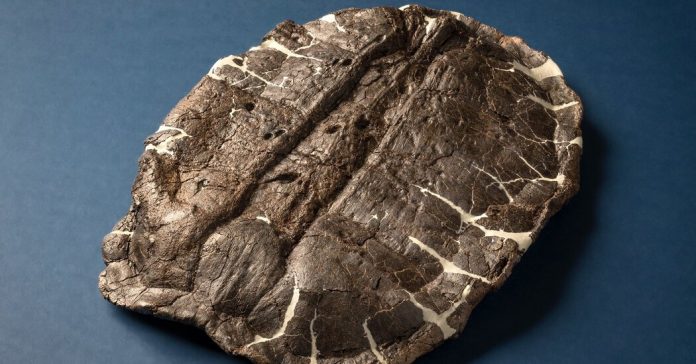There’s additionally been quite a lot of primary analysis completed on how turtle shells carry out below strain, which helped to tell the invention of the Turtle Compression Index. The group checked out roughly 70 full shells: 21 from Corral Bluffs, 44 from the Cretaceous rocks of the Hell Creek Formation within the Western United States and 5 from different earlier Cretaceous and Jurassic interval websites. Then, they measured the place the shells fell on the spectrum, Dr. Petermann stated, of “regular excellent turtle shell to pancake.”
The entire shells confirmed sure constant patterns at numerous ranges of compression. First, the shells cracked above the hip. Then, alongside the aspect of the backbone. “The extra sand I bear onto it, the flatter it will get,” Dr. Petermann stated. “After they get actually flat, they’ll have a bit of wall working round them. That’s the sting of the shell.”
The opposite key to the Turtle Compaction Index is to determine how porous the sediment of a web site is — how a lot open area exists between every grain, such because the distinction between coarse sand and fine-grained, dense silt. The connection between porosity and depth is effectively understood in geology, Dr. Petermann stated: Petroleum geologists will drill a pattern realizing the depth, then work out how porous the pattern is to foretell the existence of oil and fuel reservoirs. The turtle group simply labored in reverse — they found out how porous the positioning was, found out how a lot strain was required to crack a turtle shell, and solved for depth.
Utilizing the Turtle Compaction Index at Corral Bluff, Dr. Petermann stated, they discovered that most of the turtles had been buried within the ooze on the backside of waterway, and over time below beds of silt round 1700-1800 toes deep. The denser the unique sediment, the extra deeply the turtles had been buried.
The chelonian-crunching technique will also be utilized to different turtle-rich fossil websites the place shallow burial histories have been suspected however robust to substantiate. “If in case you have the turtles, you then actually can start to determine how a lot burial these items have undergone,” stated David Fastovsky, a paleontologist on the College of Rhode Island who was not concerned within the research. He added that the paper is “actually neat.”
Turtle energy won’t be the one technique for measuring these types of shallow websites, Dr. Petermann stated. Mammal skulls from the Cenozoic period are likely to shatter across the opening of the snout, he stated, whereas crocodile skulls usually break at a weak spot between the eyes. It’ll take some work to determine how these patterns relate to particular depths.
If these types of options to geological issues appear to come back from left area, Dr. Petermann and Dr. Fastovsky each level out, that’s as a result of they take a specific amount of lateral pondering to invent. Proxies utilizing fossil pollens and the enamel of eel-like vertebrates known as conodonts are the standard strategies of measuring deep burials, Dr. Petermann stated, partially due to their altering colours below sure ranges of warmth and strain. Nevertheless, none of them are instantly intuitive.


